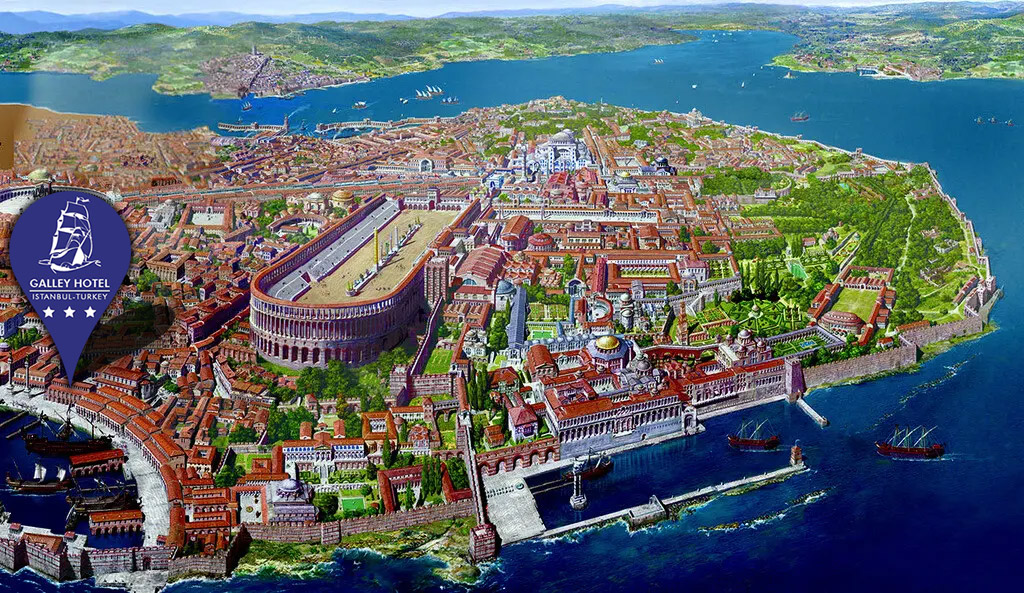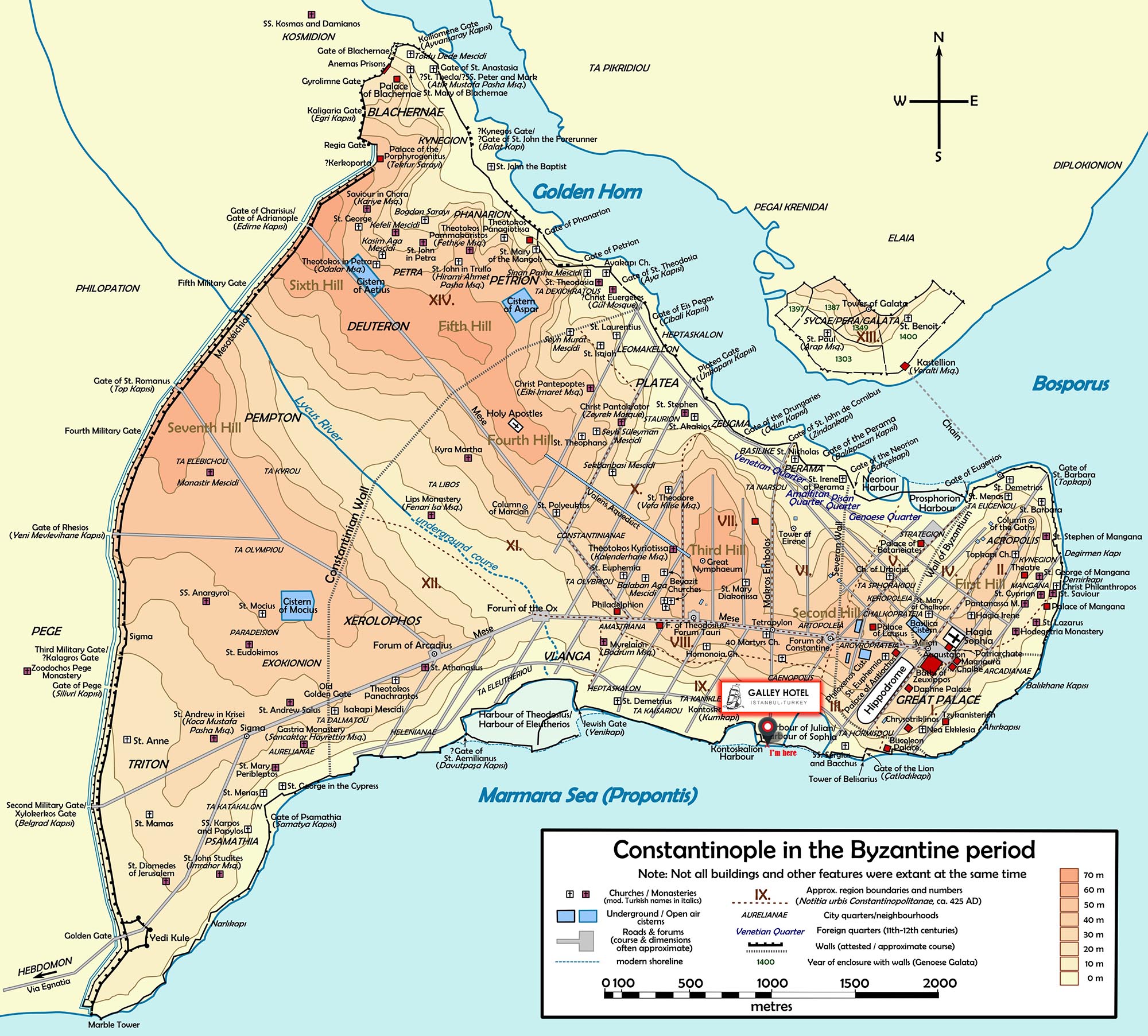Constantinople; It is a city that was the capital of the Roman Empire, Byzantine Empire, Latin Empire and Ottoman Empires. In the Republic of Turkey, the city has been officially called Istanbul since 1930.

Right next to Kontos Kalion Port:
During the Byzantine period, Kumkapi was called "Kontoskalion", which means "small pier". Even after the conquest, this name was used by the Greeks for a while. Emperor VIII. The shipyard was built by Mihael Paleologos in 1263. The wall foundation of the shipyard, which was built with large stone blocks stacked on top of each other, was exposed in a fire in 1819. The old port was filled over time and left its place to the piers where the ships that brought sand to the city unloaded.

Located on the Other Side:
Kadirga is a district in the Fatih district of Istanbul, which also includes the Kadirga Square, a large harbor where galleys were sheltered in the past. Kadirga, the oldest port of Byzantium, has also been called Portus Novus (New Port), Justinus Port and Sophia Port throughout history in Kadirga, which is a quiet district with centuries-old trees today. The first name was given to Emperor Justinus (361-578), who had the port built.
II. During the reign of Justinus (565-578), the port was named after the empress because of the repairs and additions by the empress Sophia. Sophia Harbor was one of the most important centers of Byzantium, as it was on the road from Hagia Sophia and Atmeydani to the sea and close to the emperor's palace (Bukeleon). Here, apart from various statues and monuments, there was also a gathering area for traders called "Sigma".
Antuan, archbishop of Novgorod, who visited Istanbul a short time before the Latin invasion, described the Galley Harbor as follows: "While from Ipodrome to Condoscopum, one encounters the enormous iron gate with a railing. The sea passes through this grille and goes into the city. On stormy days. It holds about 300 ships with 2-3 hundred oars."
Kadirga Harbor was used until the end of the Byzantine Empire, and after the Ottoman conquest of Istanbul, it was once a pier for small ships. According to the testimony of Gyllius, who came to Istanbul towards 1550, the port was surrounded by walls. But there was still a puddle there, and the women of the neighboring houses used to do their laundry here. Today, Kadirga Square is a promenade of the people and a playground for the children of the neighborhood. The four-cornered fountain here, III. It was built by Ahmet's daughter Esma Sultan (1724-1787). According to the verse inscriptions found on both sides of the fountain, the date of construction is 3 Åaban 1193 (5 August 1779); In these inscriptions, Esma Sultan's wife, grand vizier Muhsinzade Mehmed Pasha (who was deceased at that time) is mentioned. The verse of the inscriptions is Tevfik Efendi, and the calligrapher is Mehmed Åevki Efendi. The upper part of the fountain, which can be reached by stairs, is the prayer hall.
And finally, the Bukaleon Palace is located at the end of the galley port known as the Son:
Bukoleon Palace, (Greek "bull" and "lion" in order), a Byzantine coastal palace located in Istanbul, just east of Little Hagia Sophia, in the Catladikapi location between today's Cankurtaran and Kumkapi on the shore of the Marmara Sea of the historical peninsula. .
Judging by its name, which is thought to come from pre-Christian times, it can be thought that its history goes back to ancient times (Bukoleon Harbor). However, the first information about the palace belongs to the middle Byzantine period (mid 9th century to the beginning of 13th century). Accordingly, Bukoleon Palace Emperor II. It was built by Theodosios (reigned 408-450). The known and still visible parts were probably added in the time of Theophilos (829-842).
Between the lighthouse called Faros and the cape used as the imperial pier, marble blocks from antiquity were used on the foundation of the Bukoleon Palace, which stretches over the city walls. The 300 m long front façade, which can be seen between the city walls, consisted of two main parts. A monumental staircase connecting the palace with the small port in front and passing through a short south-north-directed wall separated these two parts. The western part of the palace was destroyed by railroad construction in the 1870s. There was a bay window decorated with sitting lion statues on both sides of this section. The east side of the palace is still standing. As can be seen from here, the exterior consists of spaces covered with successive brick vaults. It is understood that in front of the palace, which opens to the Marmara Sea with a series of marble-framed windows and doors, extends a full-length balcony supported by marble consoles embedded in the wall.
The spaces on the Faros side were decorated with richly decorated columns. A few of the pier bodies belonging to these are still exhibited in the Istanbul Archeology Museum. There were also other capitals on the east side, with various elegant ornaments. A few of these remain unprotected in the environment today. The unprotected palace ruins are open to looting.
Best Price Guarantee
Offering up to 25% discount on early reservation.
24 Hours Service
Reception is available 24/7 for assistance and information.
Private Transfer Service
Providing private transfer service to Galley Hotel from Istanbul Ataturk Airport (IST) and Sabiha Gokcen Airport (SAW). Please contact for detailed information and pricing.

 Wifi
Wifi Air Conditioning
Air Conditioning Hot Water
Hot Water Cafe
Cafe Breakfast
Breakfast Room Service
Room Service Wake-up Service
Wake-up Service Reception
Reception Transfer
Transfer Car Park
Car Park Mini Fridge
Mini Fridge Hotel Safe
Hotel Safe Security Camera
Security Camera Bicycle
Bicycle Dry Cleaning
Dry Cleaning Tv
Tv Smoking Area
Smoking Area Mini Library
Mini Library






